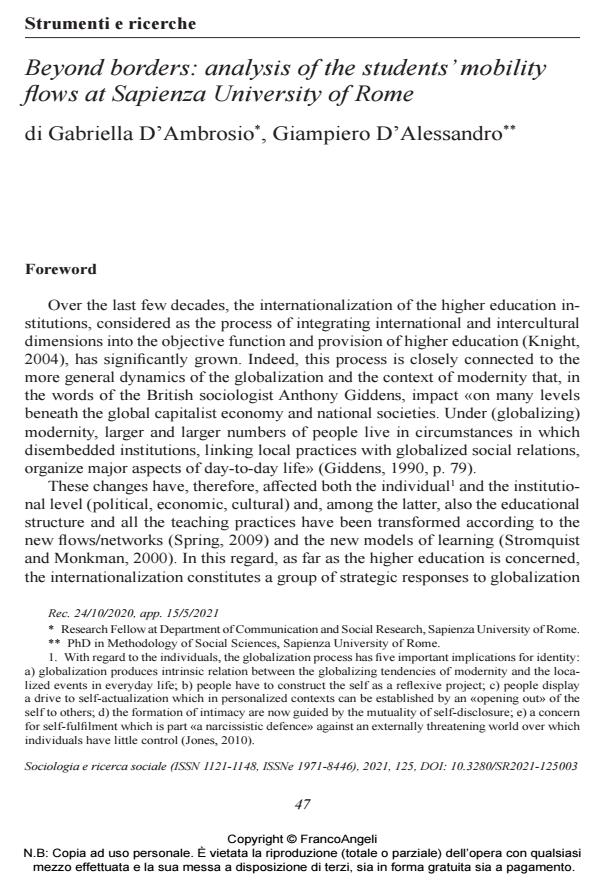Beyond borders: analysis of the students’ mobility flows at Sapienza University of Rome
Titolo Rivista SOCIOLOGIA E RICERCA SOCIALE
Autori/Curatori Gabriella D’Ambrosio, Giampiero D’Alessandro
Anno di pubblicazione 2021 Fascicolo 2021/125 Lingua Inglese
Numero pagine 18 P. 47-64 Dimensione file 498 KB
DOI 10.3280/SR2021-125003
Il DOI è il codice a barre della proprietà intellettuale: per saperne di più
clicca qui
Qui sotto puoi vedere in anteprima la prima pagina di questo articolo.
Se questo articolo ti interessa, lo puoi acquistare (e scaricare in formato pdf) seguendo le facili indicazioni per acquistare il download credit. Acquista Download Credits per scaricare questo Articolo in formato PDF

FrancoAngeli è membro della Publishers International Linking Association, Inc (PILA)associazione indipendente e non profit per facilitare (attraverso i servizi tecnologici implementati da CrossRef.org) l’accesso degli studiosi ai contenuti digitali nelle pubblicazioni professionali e scientifiche
The promotion of mobility among academic staff and students is one of the main objectives of the Bologna Process, a mechanism that has been defined by the European Commission aimed to promote intergovernmental cooperation between the European countries in the field of the higher education. In this respect, according to the last Erasmus+ Annual Report (2019), almost 10 million people took part in the Erasmus program during the last three decades and the increase of this phenomenon has been recorded in all of the European countries. As far as Italy is concerned, in 2018 (year of last available data), 76,847 participants in 1,055 Italian projects benefited from mobility in higher education, vocational education and training, school education, adult learning and youth for a total grant amount of €147.83 million. Going into detail, the number of incoming students and trainees increased by 45.8% from the 2010/2011 academic year to the 2017/2018 academic year while the number of outgoing students and trainees increased by 75.6%. Starting from this consideration, the purpose of the study was to analyze data regarding mobility flows (both incoming and outgoing) during the last academic year (2018/2019) at Sapienza University of Rome, which, together with Alma Mater Studiorum - University of Bologna and the University of Padua, is one of the top three Italian universities with the highest rate of incoming foreign students. Data will be analyzed through the use of profile analysis whose aim is to compare the same dependent variable (i.e., the opportunity for a mobility period abroad) between two different groups of incoming and outgoing students taking into account both demographic variables (i.e., gender, student age at the beginning of the experience, countries of the original and destination institutions) and variables of the academic career (i.e., exam grades and credits obtained).
Gabriella D’Ambrosio, Giampiero D’Alessandro, Beyond borders: analysis of the students’ mobility flows at Sapienza University of Rome in "SOCIOLOGIA E RICERCA SOCIALE " 125/2021, pp 47-64, DOI: 10.3280/SR2021-125003